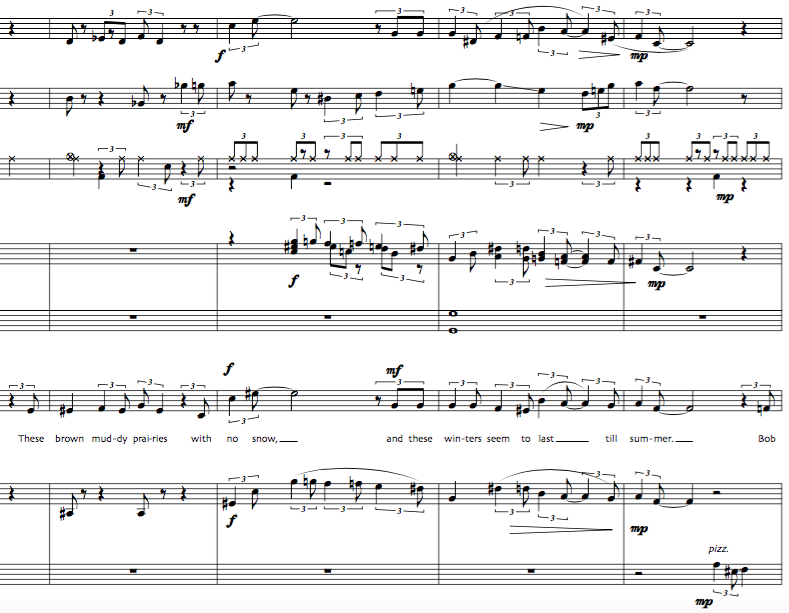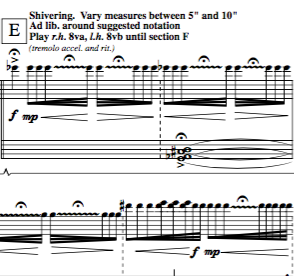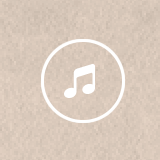Work samples
-
Bursting at the Brim"Bursting at the Brim" was written for Pique Collective and choreographed by the Black Cherry Puppet Theatre. It's the second movement of a larger piece, "Mountain Piques."
-
Kings Highway / Stillwell Ave."Kings Highway / Stillwell Ave" is a piano piece I wrote as part of my "Music, Film, and Photography" project. Vin Grabill made the piece into a film. The film was screened at the Windup Space in Baltimore, as well as Artisphere in Arlington, VA.
-
Reed Quintet No. 1, performed by the Civitasolis Quintet)
Heroes and Villains (25') was completed in collaboration with the Civitasolis Quintet. This virtuosic piece blends American sounding melodies with dark satire. I continue my collaboration with the Civitasolis Quintet by writing a second concert length piece for them. This work was premiere at the Hargrove in Baltimore City.
-
"The Food Chain," by Elliott GrabillMany thanks to Baltimore artists Aaron Thacker and Taylor Boykins for performing this! The song reveals the cynicism and hopelessness of someone being bullied.
About Elliott

Post-romantic composer Elliott Grabill has composed for two decades, teaching math by day at Baltimore City Public Schools by day, and writing music by night. His works embrace romanticism, emotion, maximalism, and complex harmony. His strongest inspiration is the challenges he faces in life: his tumultuous career as a teacher, and his struggle with epilepsy. His music has been described as “sumptuous and gorgeous,” “hauntingly beautiful,” and “American.”
Mr. Grabill is a romantic… more
Heroes, Villains, and the Civitasolis Quintet
In 2020 I began a relationship with the Civitasolis Reed Quintet. The instrumentation of the reed quintet (oboe, clarinet, bass clarinet, saxophone, and bassoon) is rich in possiblity, in that these instruments blend together well while each maintaining a unique color and personality. I have composed about an hour's worth of music for the Civitasolis Quintet, and, thanks to an MSAC grant, we plan to record the music to an album by fall 2024.
Heroes and Villains, one of the pieces to be recorded, is a mixed bag of five movements that encapsulate archetypal emotions relevant to today's zeitgeist. "Heroes and Villains” (infighting), "Dark Money” (corruption), "Jeering Song” (lip service), "Patty Cake” (deceit) and finally, “Elegy” (death) are the stories one sees every day on the news. Overall, the piece has a dark, satirical tone, unpredictably shifting musically between play, ridicule, and rage. Though often dissonant and challenging, the themes derive from an eclectic array of catchy folk-like melodies (along the lines of Charles Ives) that make the music accessible to listeners of many backgrounds. The Civitasolis Quintet has premiered Heroes and Villains in Baltimore at the Hargrove. Since then they've also performed it at ClarinetFest in Denver, and will perform it at USC later this year.
A second half hour piece will appear on the album called Music for Weddings, meant to contrast with emotionally with the wryness of Heroes and Villains. This rapturous, majestic work embraces vulnerability in a way that’s also sophisticated and ornate. It stacks long sequences of harmonies, incorporates quarter tones into the melodies, and uses dizzyingly ecstatic gestures.
-
Reed Quintet No. 1, performed by the Civitasolis Quintet)My first reed quintet (25') was completed in collaboration with the Civitasolis Quintet. This virtuosic piece blends American sounding melodies with dark satire. I continue my collaboration with the Civitasolis Quintet by writing a second concert length piece for them. This work was premiere at the Hargrove in Baltimore City.
-
II. Dark Money (by Elliott Grabill / performed by Civitasolis Quintet)
-
III. Jeering Song (by Elliott Grabill, performed by the Civitasolis Quintet)
-
IV. Patty Cake (by Elliott Grabill, performed by the Civitasolis Quintet)
-
V. Elegy (by Elliott Grabill, performed by the Civitasolis Quintet)
Words of the Amish
In 2017, I met an Amish couple on the train back from Chicago. I gave them my address, and I told them I wanted to learn more about their language and culture. Three weeks later, I received a big black dual language Bible in English and the York County dialect of Pennsylvania Dutch. I spent months deciphering the language, finally receiving language coaching from Douglas Maddenford, a non-Amish speaker of Pennsylvania Dutch.
So far, I have set two texts from the Bible to music. The imagery in Psalm 23 - Da Ha iss mei Schopfhieder reminds me of rural Pennsylvania and is heavily influenced by American religious folk music. The rustic Matthew 5:38 - Liewe eier Feinda encapsulates a core Amish believe: love your enemy. Its harsh minor key sounds more like a hybrid of baroque music and Swiss folk music from the time the Amish immigrated to America.
While not dissonant, these two works weave through a complex sequence of harmonies. To guide the singers, I chose not the piano, but the viola da gamba. This instrument adds a German folksiness to the piece. The gamba was prominent in the Switzerland and southern Germany when the Amish migrated from there to the United States in the 18th century.
In 2023, Psalm 23 was performed in Minnesota at the Christian Fellowship of Art Music Composers. I am currently setting a text from Ecclesiastes 1.
I'm hoping will one day become a concert length religious choral work, though funding this project will be a challenge. However, I find pursuing the project worthwhile. The tenets of Amish culture, such as the belief in forgiveness and non-violence, could heal America of its polarization. Pennsylvania Dutch is spoken by 300,000 Amish and non-Amish people and differs greatly from German in grammar and lexicon. Its ornate words beget emotions with more heart than Latin or English, the preferred languages of American religious music. and few pieces have been set in Pennsylvania Dutch in the 21st century. The Amish originally settled in Pennsylvania and the midwest, but Amish diaspora now stretches across the country.
Teacher Tales
Teacher Tales bears witness to America's struggling education systems. "My Biggest Mistake" is based on a conversation with a Baltimore mother had to work so hard to provide her son with the basic necessities that she regretted even having a him. "The Food Chain" is my cynical reflection on bullying, and "A Serf To Your Wage" parodies the lessons taught in schools that, as Noam Chomsky puts it, manufacture consent. I borrow musical ideas from cabaret, jazz, and twelve-tone music to give these sinister texts an American flavor. These songs were runner up in the Arcade Emerging Composers Competition.
As a teacher, I authored the lyrics to these songs. Unlike many "social justice pieces," this work wasn't written in an ivory tower; it's a direct product of someone who has toiled, lost sleep, and suffered anxiety from working the front lines. I don't know everything about society, but I think our schools are a microcosm of society at large. Stories of how the system is failing our children demonstrates the general decline of American society.
-
"A Serf to your Wage," by Elliott GrabillWhen I started this song cycle, my goal was to point out issues facing education, from nine years of teaching math. When I finished the piece, I realized that I had critiqued much more than education. School was just my metaphor for societal woes.
-
"The Food Chain," by Elliott GrabillThe music from "The Food Chain" is derived from a twelve tone row. The text uses animals as metaphors for both bullies and victims. Pretending not to be weak, acting opportunistically, and attaching one’s self to a clique are all coping strategies for being bullied. Students learn these strategies at school, and carry them throughout their lives.
-
"My Biggest Mistake," by Elliott GrabillMy Biggest Mistake is told from the perspective of an overworked, underpaid mother just trying her best. Still a teen, she is beginning to wonder if having a child was a mistake. Though this character is pro-life, the song demonstrates the economic consequences that women and children still would face if abortion were made illegal.
-
"The Day He Left," for soprano, oboe, and pianoThis is the first song in my song cycle "Grief Never Leaves," showing three glimpses into the emotional turmoil of a woman who has lost someone very dear-- yet not knowing if he is alive or dead. She suffers from the pain of loss, constant uncertainty, and a tepidness to move on in hopes that he may come back. This song focuses on the shock of losing her lifelong companion in the blink of an eye. It is ridden with the anxiety someone experiences after the first couple of weeks after losing someone.
-
"Grief Never Leaves," for soprano, oboe, and pianoThis is the third song of "Grief Never Leaves," a cycle providing glimpses into the emotional turmoil of a woman who has lost someone very dear-- yet not knowing if he is alive or dead. This song ruminates on the persistence of grief. Time and therapy help, but it never really goes away. Grief is complex, and grief is intense-- worse than physical pain. Many thanks to Lydia Consilvio, Laura Snyderman, and Lior Willinger for performing this.
-
"Making the Year," for mixed chorus, by Elliott GrabillThis choral piece is a setting to a poem by Nova Scotian poet Bauke Kamstra.
-
"Nantucket," for men's chorus, by Elliott GrabillI wrote this piece for the Washington Men's Camerata in 2010. It was performed at the Kennedy Center later that year in DC.
-
 My Biggest MistakeLyrics to the song "My Biggest Mistake"
My Biggest MistakeLyrics to the song "My Biggest Mistake" -
 "They're gonna cut his Medicaid"A snapshot of the score of "My Biggest Mistake." This song written from the perspective of a teenage mother who is forced to work three jobs, for fear that she'll lose her son's health insurance.
"They're gonna cut his Medicaid"A snapshot of the score of "My Biggest Mistake." This song written from the perspective of a teenage mother who is forced to work three jobs, for fear that she'll lose her son's health insurance. -
 "These winters seem to last till summer"A page from the song "Seasonal Affective Disorder." This song is written in a swing jazz style, and addresses the opioid epidemic.
"These winters seem to last till summer"A page from the song "Seasonal Affective Disorder." This song is written in a swing jazz style, and addresses the opioid epidemic.
Music for Puppet Theatre
"Mountain Piques" is a composition I wrote for the Pique Collective, a Baltimore-based contemporary music ensemble. It was premiered on October 18, 2018 at the Black Cherry Puppet Theatre, who crafted abstract shapes and choreographed their movement to the music.
The work is a quartet for three acoustic instruments (guitar, flute, and cello) and a fourth musician who, using a laptop computer's trackpad, controls a range of sounds just like a normal instrument.
"Mountain Piques" embraces many classical music archetypes. Before electronics, composers used the flute’s flutter, the cello’s warmth, and the guitar’s intimacy to convey imagery of nature. I add a psychedelic quality to the work's pastoralism with audio samples of birds, frogs, and ambience. Like much classical music, the piece also explores rhythmic complexity, polyphony, and uses four contrasting movements as an expressive canvass.
The slow first movement, "The Rainforest," ends with the metaphor of a ticking clock. "Bursting at the Brim," the title of the second, scherzo-like movement, comes from a line from “Ode to a Nightingale,” by John Keats. Electronics this time bring in the sounds of birds, again creating a musical metaphor.
"The Heaven of Animals" and "Waterfall" are longer and more experimental. In these movements, sounds of the forest become erie, with undulating pitched rhythms, and an aggressive electronic part. These movements also contain virtuosic solos in the cello, guitar and flute parts. One section features a drum with the flute, guitar, and cello perform much like their ancestor instruments from the Middle Ages. While the flute is normally considered a high pitched instrument, the third movement uses an alto flute to explore a darker, more melancholy side to the flute.
This project took about a year to complete. I spent seven months writing it, and the Pique Collective spent an additional four months learning to play it. The Pique Collective, whose vision is to bring new music to alternative venues, reached out to Black Cherry Puppet Theatre to create visuals for the piece. Puppeteers Michael Lamason, Jeanine Padgett, Emily Schubert, and Alissa Glenn crafted large, abstract shapes and choreographed them to the music.
-
Mountain Piques - I. The RainforestThe piece opens with the musicians tip toeing through a quiet, mystical soundscape.
-
Mountain Piques - II. Bursting at the BrimThe second movement of "Mountain Piques" is a colorful scherzo with intricate rhythms. Towards the end of the piece, I incorporated recordings of blackbirds into the melody.
-
Mountain Piques - III. The Heaven of AnimalsThe third movement of "Mountain Piques" is more experimental than the first two. It uses a laptop, which the musician uses to control the pitch of electronic sounds being generated.
-
"Mountain Piques" live performanceA live video of the Pique Collective performing "Mountain Piques," with the Black Cherry Puppet Theatre performing choreography.
-
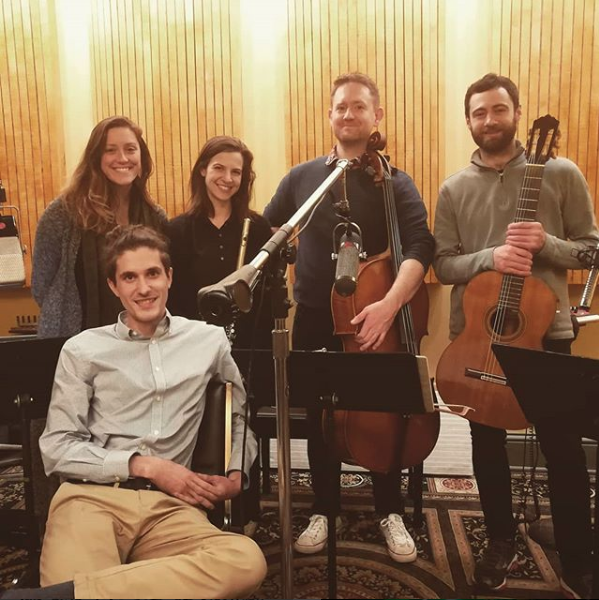 Recording "Mountain Piques"Lisa Perry, electronics; Stephanie Ray, flute; Peter Kibbe, cello; Jeremy Lyons, guitar; Elliott Grabill, composer
Recording "Mountain Piques"Lisa Perry, electronics; Stephanie Ray, flute; Peter Kibbe, cello; Jeremy Lyons, guitar; Elliott Grabill, composer -
 Black Cherry PuppeteersA photo of the premiere of "Mountain Piques," including the Pique Collective performing the piece, and puppeteers of the Black Cherry Puppet Theatre performing choreographed visuals.
Black Cherry PuppeteersA photo of the premiere of "Mountain Piques," including the Pique Collective performing the piece, and puppeteers of the Black Cherry Puppet Theatre performing choreographed visuals. -
 Mountain Piques PosterThis image was designed by Peter Kibbe to advertise "Mountain Piques" on social media.
Mountain Piques PosterThis image was designed by Peter Kibbe to advertise "Mountain Piques" on social media. -
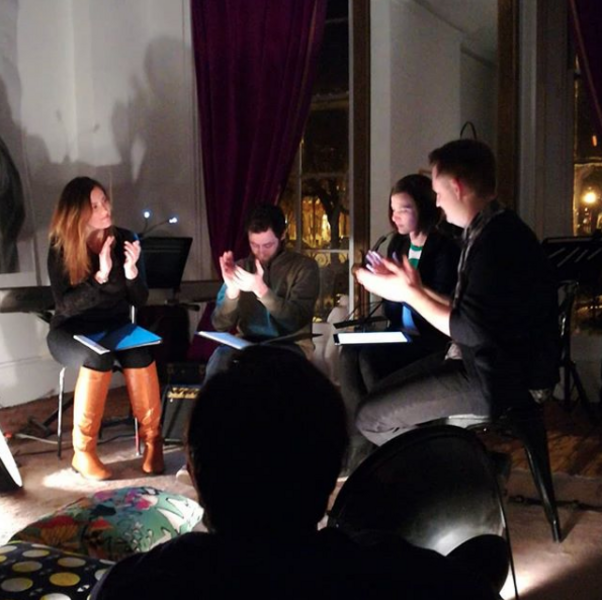 Pique CollectivePerforming at a house concert in Baltimore
Pique CollectivePerforming at a house concert in Baltimore -
Mountain Piques - IV. WaterfallThe fourth movement of "Mountain Piques" is the longest movement, and combines aspects of the first three movements.
Vibrating Piano Strings
"Un Jardin" is a work for fixed media in three movements, which Vin Grabill later set to visuals. It has an extremely angelic tone, beginning with a repeating, warbly, hymnlike chord progression, and leading to an overwhelming climax. "Ceres," the second movement, is simply a cluster of every piano key at the same time. The lightness of the piano sounds turns the dissonance into a shimmering texture, highlighting some keys more than others to create melodies inherently connected with sound.
I continued experimenting with recordings of piano strings in "Pranayama," which sparsely features samples of synthesizer and my own voice to add a tinge of color to the piano sounds. "After the Storms," incorporates the sounds of electric guitar, handbells, windchimes, buzzing home appliances, and computer synthesis. It begain as a dance piece choreographed by Danielle Greene and performed at the Boyer College of Music and Dance at Temple University, also heavily uses piano string recordings. Later Vin Grabill made it into a video piece.
These three pieces have been featured at a variety of venues. "After the Storms" was presented at the SEAMUS conference, and "Pranayama" was presented at the International Computer Music Conference. They've also been shown at the Church of the Holy City in DC, the Vitruvian Gallery in DC, the Tin Roof Brewery in Baton Rouge, and broadcasted on WTJU.
-
Un Jardin
-
PranayamaMusic by Elliott Grabill, video by Vin Grabill
-
After The Storms
-
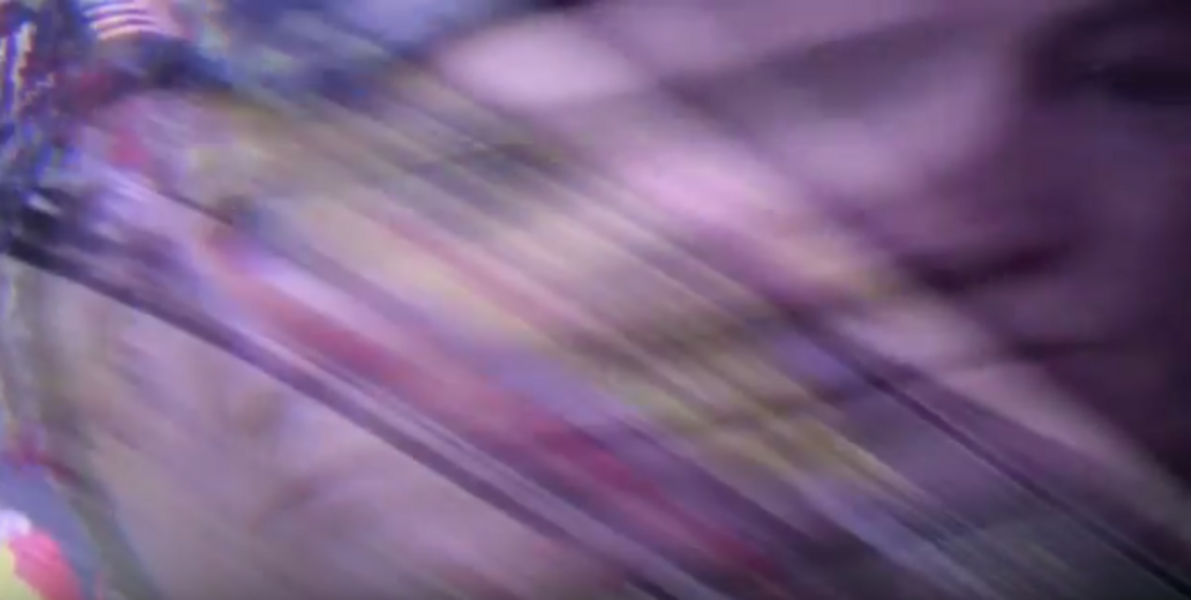 From "Un Jardin"A still from the Vin Grabill's visual interpretation of "Un Jardin." Featured is an Olympic swimmer, filmed through a convex plexiglass lens in front of a television set. Superimposed is a cheering crowd.
From "Un Jardin"A still from the Vin Grabill's visual interpretation of "Un Jardin." Featured is an Olympic swimmer, filmed through a convex plexiglass lens in front of a television set. Superimposed is a cheering crowd. -
 From "Pranayama""Pranayama," which was set to film by Vin Grabill, has a flowing, multilayered quality, much like the colorful, flowing belts of green and purple seen here.
From "Pranayama""Pranayama," which was set to film by Vin Grabill, has a flowing, multilayered quality, much like the colorful, flowing belts of green and purple seen here. -
 From "After the Storms"A still from "After the Storms"
From "After the Storms"A still from "After the Storms" -
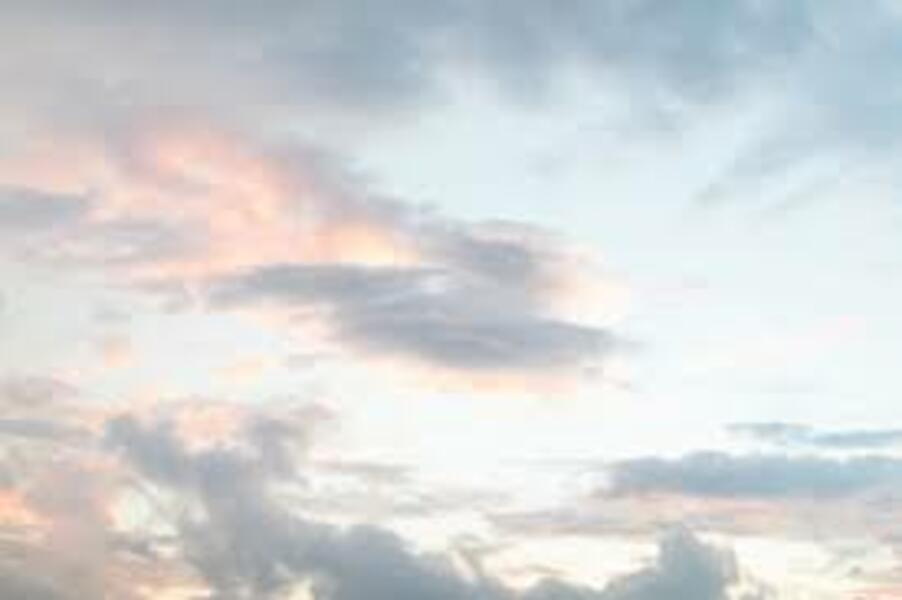 CloudsThe thin texture of cirrus clouds was one of my inspirations to write "Un Jardin." Water is emotion, and to me, cirrus clouds represent the cold, icy, and unattainable.
CloudsThe thin texture of cirrus clouds was one of my inspirations to write "Un Jardin." Water is emotion, and to me, cirrus clouds represent the cold, icy, and unattainable. -
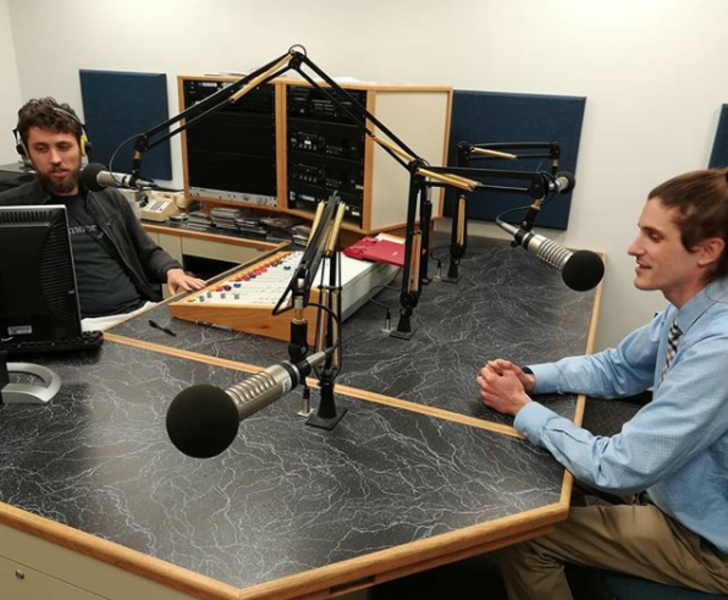 Interview with John ScherchOn my soundcloud profile, I talk with John Scherch of WBJC about "Un Jardin," "Lake Pontchartrain," and "Enkidu."
Interview with John ScherchOn my soundcloud profile, I talk with John Scherch of WBJC about "Un Jardin," "Lake Pontchartrain," and "Enkidu." -
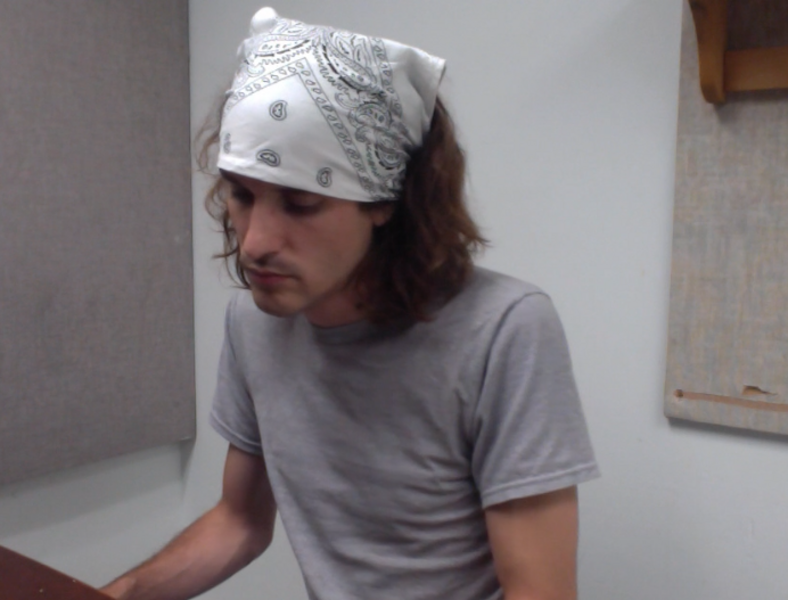 Recording the pianoI make it a point to record pianos wherever I go, usually just a single note or chord. Every piano sounds a little different, and I use these nuances to change the music's timbre over time.
Recording the pianoI make it a point to record pianos wherever I go, usually just a single note or chord. Every piano sounds a little different, and I use these nuances to change the music's timbre over time. -
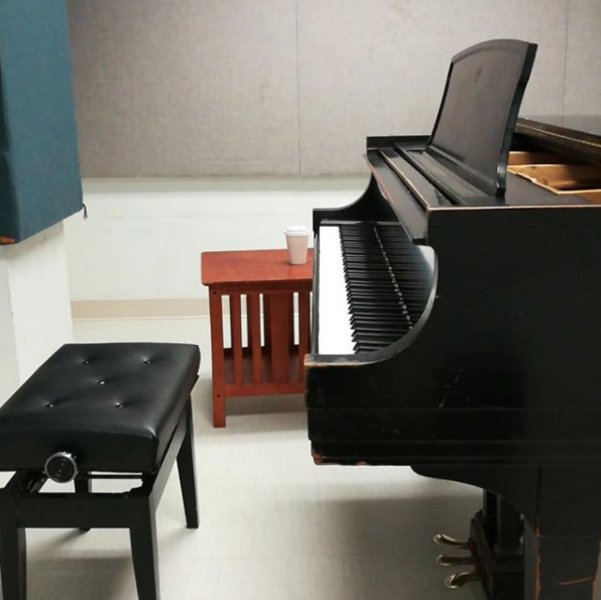 Recording the pianoI've collected audio samples of hundreds of chords from pianos throughout my life.
Recording the pianoI've collected audio samples of hundreds of chords from pianos throughout my life.
Music, Film, and Photography
The last night I spent in my Queens apartment was nightmarish. Heat radiators were going off, water was dripping from a faucet, and I heard sounds in my own head. I was also hyper-aware of the sounds I heard when I walked out of my last day at work. The relief of never having to return quieted my mind enough to hear the sounds of New York's traffic and children laughing.
After composing it and performing it at the Church of the Holy City in Washington, DC, Vin Grabill created a video to accompany it from hundreds of photos I took in New York. The video was featured at the Rosebud Film Festival.
-
Kings Highway / Stillwell Ave., BrooklynMusic written and performed by Elliott Grabill, photography by Elliott Grabill, video by Vin Grabill
-
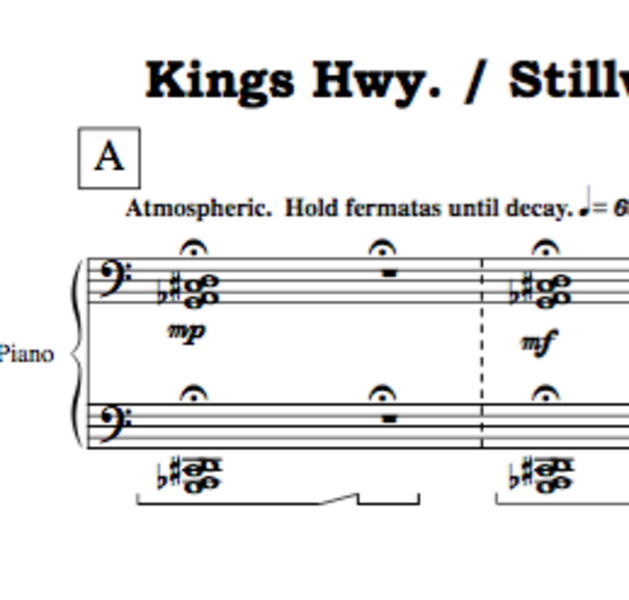 Kings Highway beginning"Kings Highway" has a very free tempo, focusing on gesture and color. These single chords in the dark, lower reaches of the piano resemble the thundercloud over my head, and set the tone for the piece.
Kings Highway beginning"Kings Highway" has a very free tempo, focusing on gesture and color. These single chords in the dark, lower reaches of the piano resemble the thundercloud over my head, and set the tone for the piece. -
 Rosebud Film Festival"Kings Highway / Stillwell Ave." was made into a film by Vin Grabill and screened at the Rosebud Film Festival.
Rosebud Film Festival"Kings Highway / Stillwell Ave." was made into a film by Vin Grabill and screened at the Rosebud Film Festival. -
Photo featured in the filmThis is one out of a multitude of photos that were incorporated into the film of "Kings Highway / Stillwell Ave." These street signs are actually from Queens; the intersection of Kings Highway and Stillwell Ave. in Brooklyn looks similar.
-
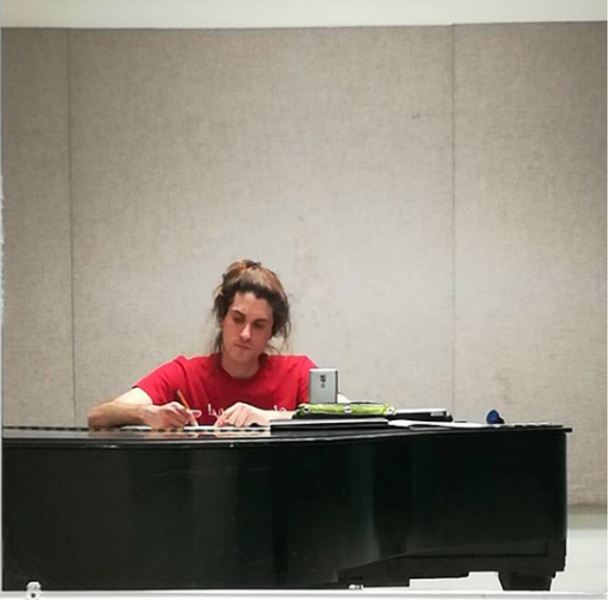 Creative processHere is a picture of me composing at the piano. Before writing down notes, I spend a lot of time sketching, improvising, recording, and listening to those recordings later to find the best material.
Creative processHere is a picture of me composing at the piano. Before writing down notes, I spend a lot of time sketching, improvising, recording, and listening to those recordings later to find the best material. -
 Kings Highway, middle sectionIn this section, the piano quivers at a very high octave range, made to resemble ice and cold. The "feathered beams" of the notes give the pianist moderate freedom to insert their own spontaneity.
Kings Highway, middle sectionIn this section, the piano quivers at a very high octave range, made to resemble ice and cold. The "feathered beams" of the notes give the pianist moderate freedom to insert their own spontaneity. -
 From the filmOne of many photos from the film of "Kings Highway." The shapes and colors of the New York City subway system are one of the many little things that make the city unique.
From the filmOne of many photos from the film of "Kings Highway." The shapes and colors of the New York City subway system are one of the many little things that make the city unique. -
 InTowner ReviewA review of a concert of my work in Washington, DC, featuring "Kings Highway" and "Uriel," a piece I wrote for tenor and live electronics.
InTowner ReviewA review of a concert of my work in Washington, DC, featuring "Kings Highway" and "Uriel," a piece I wrote for tenor and live electronics.
Romantic Chamber Music
Escape, for bassoon quartet, has been performed in New York, Maryland, Tennessee, and Spain. It's overall a bleak piece; the dark registers of the bassoons and a hulking contrabassoon solo are mixed with arcs of wailing and quarter tones.
During COVID, many musicians took their music online, performing together virtually but apart physically. This year I had the chance of working with the Civitasolis Quintet and Music&Friends Chamber Ensemble to write three shorter works: Deep Purring, All the Little Kittens, and The Dragons are My Children.
For several years, I've been working on an Edgar Allan Poe Tryptich for clarinet, piano, violin, and cello. I am hoping to make this work my masterpiece: three large scale movements that push the limits of emotion and virtuosity. Due to its difficulty, I've been having trouble getting this piece performed.
A florid Sonata for Flute, Percussion, and Electronics also sits unperformed in my bottom drawer.
-
"Lake Pontchartrain," music for string sextetA studio recording of "Lake Pontchartrain." The six string players create a lush, glassy sound, gentle like the waves of Lake Pontchartrain. In the middle, the strings emulate sounds of the bayou.
-
Escape, for bassoon quartetPerformance in February 2017 at Peabody Conservatory
-
Music&Friends Online Project New Music - The Dragons are My Children by Elliott Grabill"The Dragons are My Children," a deep, lush duet for cello and double bass. This short piece uses quarter tones and harmonics. The title was inspired by the television show "Game of Thrones.
-
"Deep Purring," Elliott GrabillDuring COVID, I had the honor of working with the Civitasolis Reed Quintet. This work incorporates the sound of a kitten purring.
-
"Walking About," for soprano, oboe, and piano"Walking About," from the song cycle "Grief Never Leaves." For more information on my song cycles, scroll up to read my portfolio piece dedicated to songwriting.
-
Lake Pontchartrain, video recordingA live performance of "Lake Pontchartrain."
-
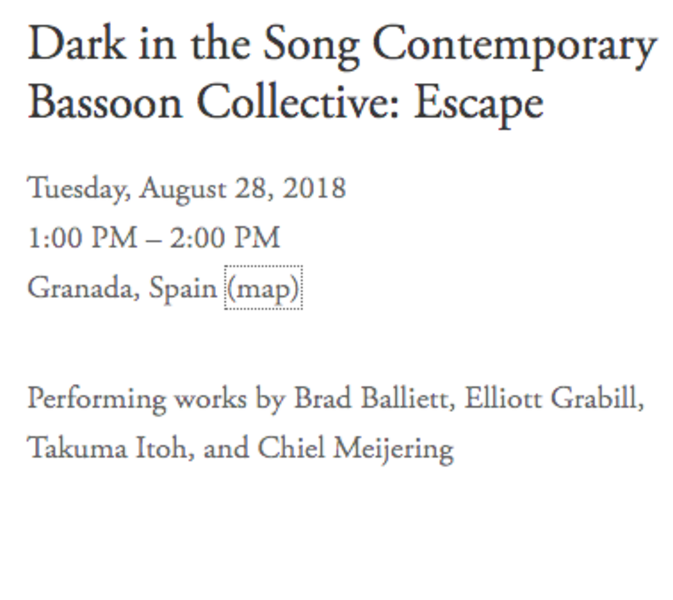 European premiereConcerts of new contemporary music often feature several composers and are programmed around a certain concept. This concert, named after the title of my bassoon quartet "Escape," features other pieces that explore that same theme.
European premiereConcerts of new contemporary music often feature several composers and are programmed around a certain concept. This concert, named after the title of my bassoon quartet "Escape," features other pieces that explore that same theme. -
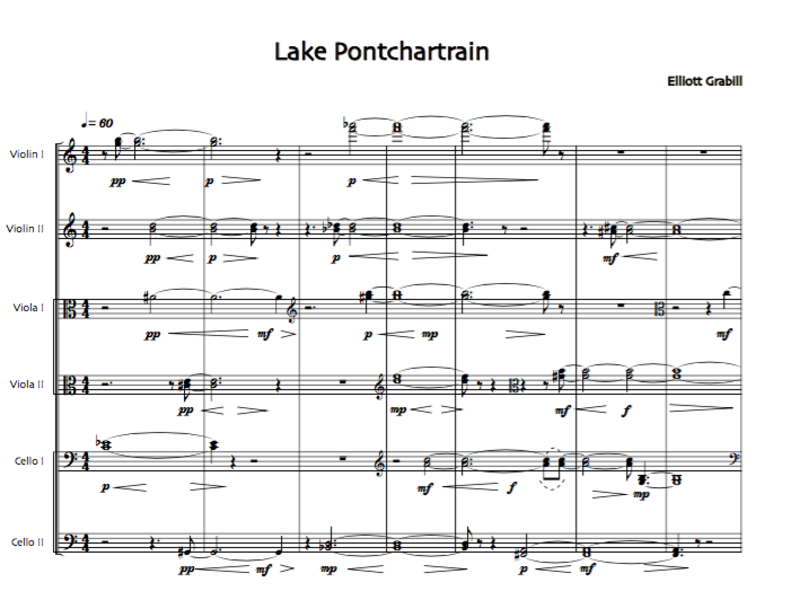 Lake PontchartrainThe first page of the score of "Lake Pontchartrain." Six stringed instruments play long notes at staggered intervals, creating the feeling of gentle waves. Though extremely dissonant, the opening is also very warm.
Lake PontchartrainThe first page of the score of "Lake Pontchartrain." Six stringed instruments play long notes at staggered intervals, creating the feeling of gentle waves. Though extremely dissonant, the opening is also very warm. -
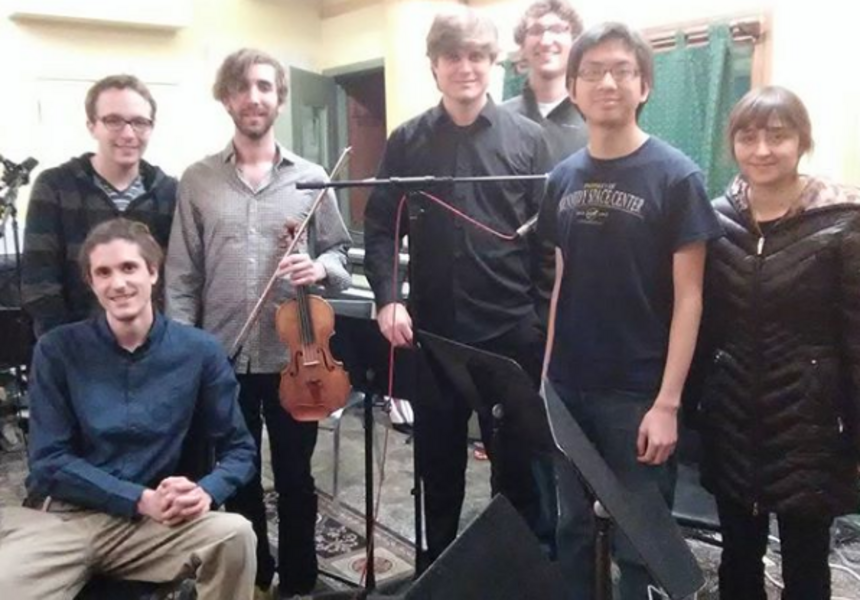 Recording sessionOur sextet recorded "Lake Pontchartrain" at Heartwood Studios in Baltimore.
Recording sessionOur sextet recorded "Lake Pontchartrain" at Heartwood Studios in Baltimore. -
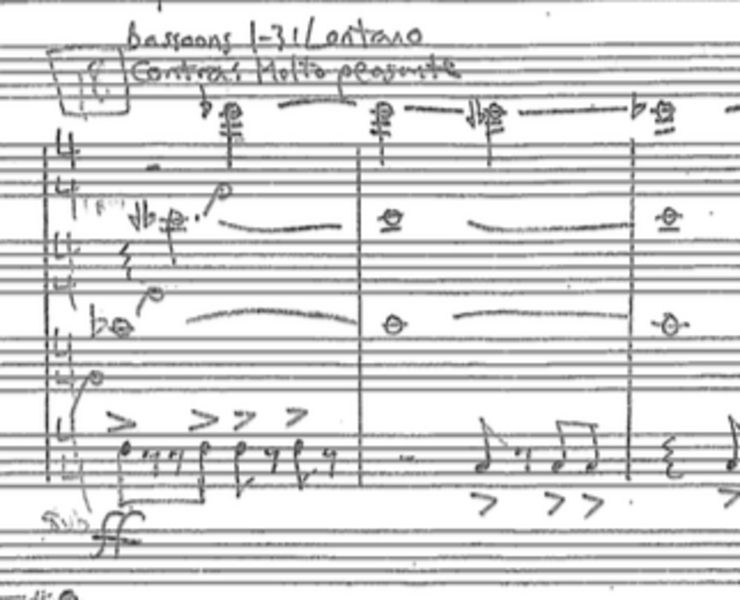 Escape, for bassoon quartetHandwritten draft of part of "Escape"
Escape, for bassoon quartetHandwritten draft of part of "Escape"
Music for Solo and Live Electronics
I'm passionate about composing music for one person and speakers. Normally, the piano accompany a musician or vocalist. Not all venues have pianos though, and I wanted to explore a different way of accompanying instruments.
My longest piece to date, Pluto, is written for just one clarinet, and one person operating electronics. Playing into a microphone, the clarinet interacts with live electronics to create a one-person orchestra. With techniques such as looping, delay, pitch shift, ring modulation, and aliasing, the clarinet creates a living surreal electroacoustic environment symbolizing interstellar space.
I repeated this process in Enkidu, for baritone saxophone and live electronics. I have also been commissioned to write a piece for bassoon, and one for alto saxophone; recordings will be released soon.
-
"Gravity" by Elliott GrabillShawn Earle performing "Gravity," the fifth movement of my forty minute long cycle "Pluto," for clarinet and live electronics.
-
"Enkidu," for baritone saxophone and electronicsTae Ho Hwang performing "Enkidu" at the Electroacoustic Barndance in Jacksonville, Florida in 2018.
-
 Solo instrument + live electronicsBelow is an example of what my music looks like on paper. The electronics turn a single instrument into a one-person orchestra. High quality speakers immerse the audience in music.
Solo instrument + live electronicsBelow is an example of what my music looks like on paper. The electronics turn a single instrument into a one-person orchestra. High quality speakers immerse the audience in music. -
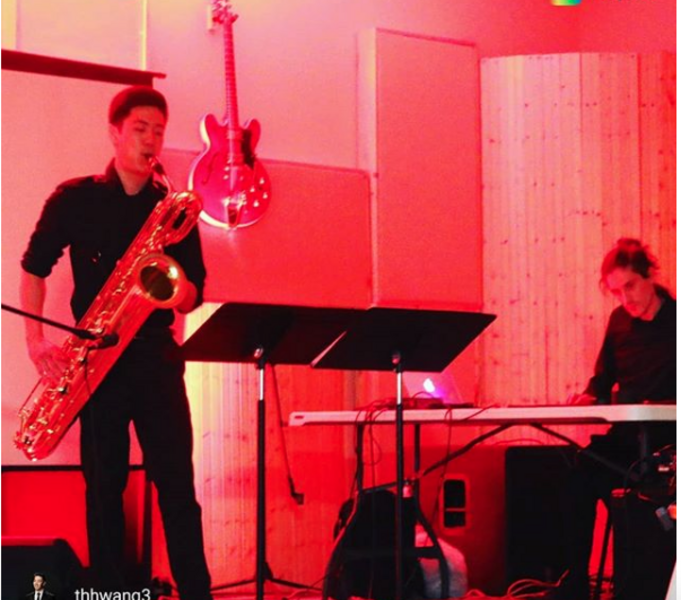 Screen Shot 2021-01-15 at 6.49.24 PM.pngTae Ho Hwang on baritone saxophone performing "Enkidu," with me at the table operating the electronics.
Screen Shot 2021-01-15 at 6.49.24 PM.pngTae Ho Hwang on baritone saxophone performing "Enkidu," with me at the table operating the electronics. -
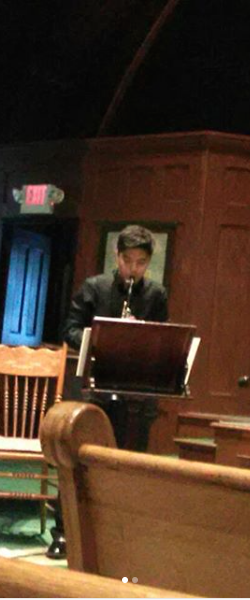 Performance in VermontAndrew Im and I have performed this piece in its entirety in Baltimore, Orange, NJ, and Rutland, VT. The piece works well in churches with a reverberant acoustic and a calming environment.
Performance in VermontAndrew Im and I have performed this piece in its entirety in Baltimore, Orange, NJ, and Rutland, VT. The piece works well in churches with a reverberant acoustic and a calming environment. -
 Pluto Concert FlierAndrew Im performed "Pluto" in its entirety in Baltimore, Rutland, VT, and Orange, NJ. We wanted to bring music to local communities. Our New Jersey concert had a strong turnout of children.
Pluto Concert FlierAndrew Im performed "Pluto" in its entirety in Baltimore, Rutland, VT, and Orange, NJ. We wanted to bring music to local communities. Our New Jersey concert had a strong turnout of children. -
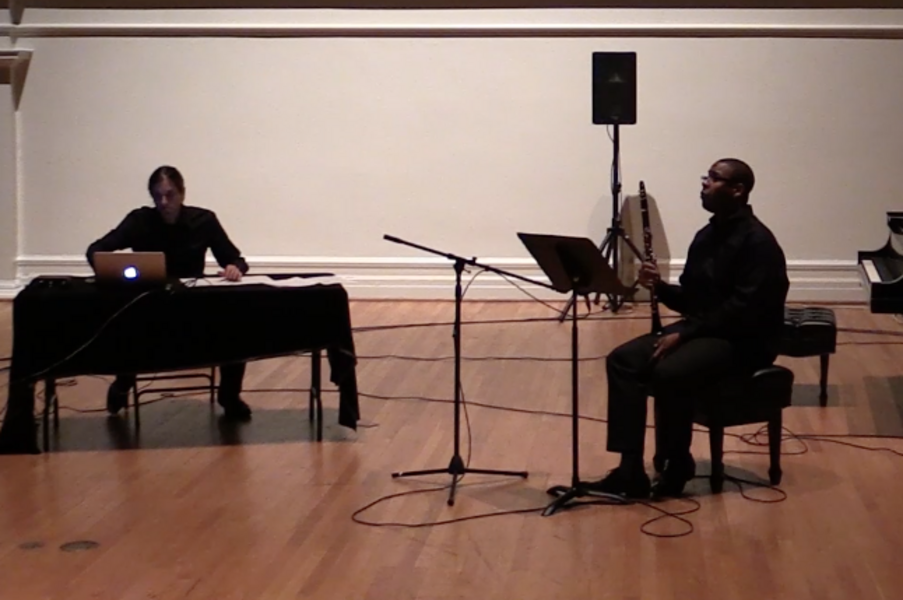 Performance at UVAShawn Earle performing "Gravity," the fifth movement of "Pluto," at the University of Virginia Technosonics Festival in October, 2016.
Performance at UVAShawn Earle performing "Gravity," the fifth movement of "Pluto," at the University of Virginia Technosonics Festival in October, 2016. -
 Performance at PeabodyMelissa Lander performing "Gravity" at the Thursday Noon Concert Series at Peabody Conservatory.
Performance at PeabodyMelissa Lander performing "Gravity" at the Thursday Noon Concert Series at Peabody Conservatory.
Solo Performance
Baltimore has a scene for people who crave new, interesting music. I've performed my solo work at Reverb, Bloom Bars, and a number of venues around the country. These works explore freedom of form, timbral variety, and lyricism in a way that's neither classical nor pop.
-
Ocean Mermaid, for MIDI controllerThis song's use of phasing and looping create a warm, undulating tone. A high pitched solo, controlled by a small MIDI controller, sounds like whistling wind (or mermaids laughing).
-
Wildflowers, by Elliott GrabillThis piece begins with a simple melody and expands into a euphoric landscape.
-
Cadmium, by Elliott GrabillThis song uses the musical coding program SuperCollider to create powerful, firey mass of sound.
-
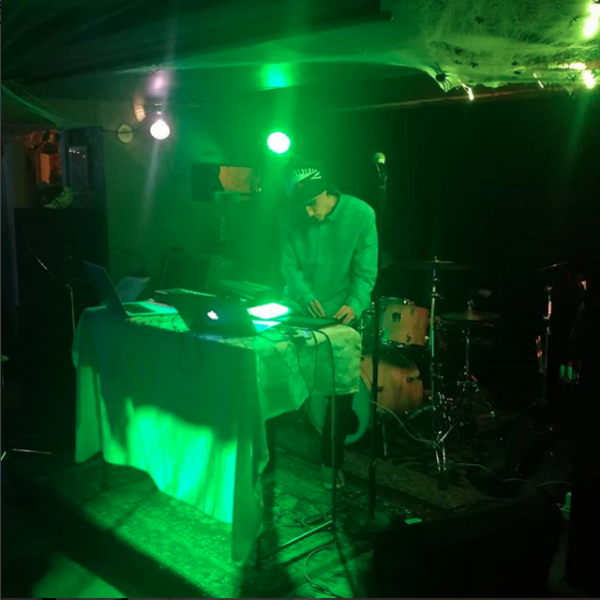 Performing at ReverbMy solo work lends itself well for underground venues. This work is too experimental to be mainstream, and too odd to be programmed in a classical concert setting.
Performing at ReverbMy solo work lends itself well for underground venues. This work is too experimental to be mainstream, and too odd to be programmed in a classical concert setting. -
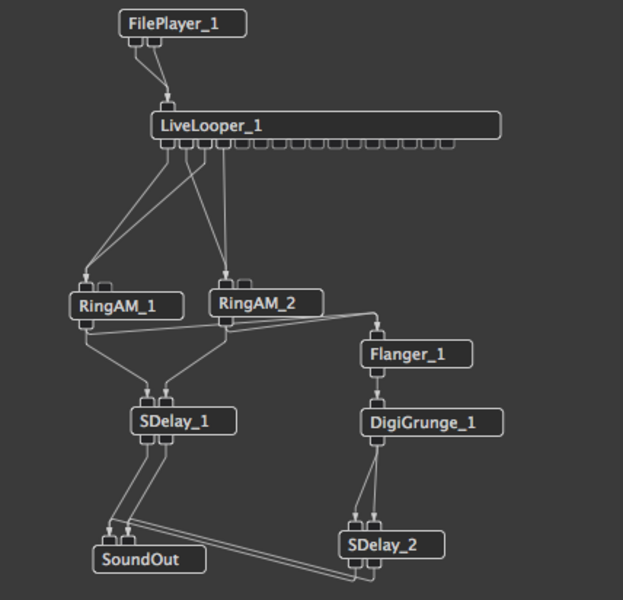 Electronic patchTo perform my work, I create patches on SuperCollider and AudioMulch to alter and process raw sound.
Electronic patchTo perform my work, I create patches on SuperCollider and AudioMulch to alter and process raw sound.



